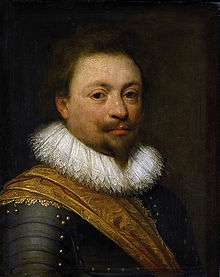William of Nassau-Hilchenbach

William of Nassau-Siegen (13 August 1592 in Dillenburg – 18 July 1642 in Rheinberg) was Count of Nassau in Hilchenbach.
Life
William was the fourth son of John VII, Count of Nassau (1561–1623) and his wife Magdalena von Waldeck-Wildungen (1558–1599).
William was educated in the Reformed faith, and studied in Heidelberg and Sedan. He was moved after the death of his elder brother Adolf in 1608, to second place in the succession. Thus, after the death of his father in 1623, he inherited the castle of Ginsburg, Hilchenbach and other places and became founder and sole representative of the line Nassau-Siegen, Hilchenbach. William lived at first in Ginsburg, and from 1623 in Hilchenbach. The local water-tower was named after him: Wilhelmsburg (William's Castle).
Like many of his family members, he was involved in the Dutch Revolt and in the Uskok War (1617) against the Habsburgs and Catholic Spain, where he received the rank of Marshal. Especially in the campaigns of 1629 and 1632 as 's-Hertogenbosch and Maastricht were captured, he distinguished himself and became governor of Heusden and Sluis. During attempted attack on Antwerp, he was devastatingly defeated in the Battle of Kallo (1638), in which his only son, 17-year-old Maurice, was killed. At the siege of Gennep in 1641, he suffered a serious abdominal wound, in consequence of which he died a year later. He was buried in Heusden.
External links
- http://www.siwikultur.de/khb/1/1/912.htm
- http://home.arcor.de/nuw-mengerskirchen/Nassau.pdf (PDF file, 54 kB )